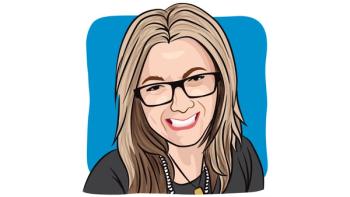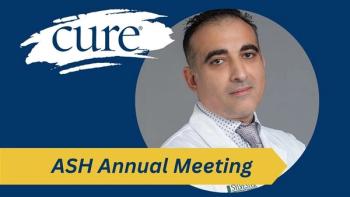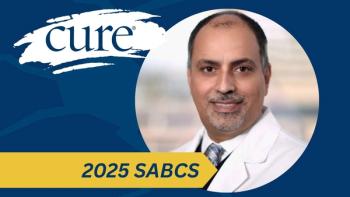
The Ins and Outs of Risk Stratification, Managing Side Effects and Survivorship in Breast Cancer
Patients who understand their roles and responsibilities may better help their care teams understand what they may be at risk for in their cancer survivorship.
Breast cancer survivors are living longer, and with that comes late-term side effects and the need for survivorship care plans to help manage them, according to an expert.
Jennifer Klemp, a professor of medicine in the division of medical oncology and the director of cancer survivorship at the University of Kansas Cancer Center, presented on survivorship at CURE®’s recent Educated Patient® Breast Cancer Summit. She focused on the need to risk stratify patients and survivors to understand what their risks are, as well as managing side effects, the gaps in survivorship care plans and the importance of screening for all cancer types.
She discussed these topics further in an interview with CURE®. “I think the biggest thing is, there is a need for that role delineation for the survivor, the providers and the extended community of practice caring for our breast cancer survivors from the time of diagnosis through the lifespan,” Klemp said. “It's important that we all understand our roles. And I think it's great that the participants attending this conference are doing this to expand their role. That's an important piece in their journey because we need to support each other.”
CURE®: Why is it important to focus on breast cancer survivorship?
Klemp:Well, breast cancer survivors have experienced some of the most significant improvements in both living with and through their cancer — patients who are cured of their disease or patients who live very extended periods of time with their disease. And breast (cancer treatment) has some of the most lines of therapy, meaning that if you were a lung cancer survivor, you may only have two or three lines of therapy, but in breast cancer, we have multiple. That means that the complexities potentially not only of the treatment, (while we're giving) the treatment, but (also) the prior treatments and the future treatments takes a combined effort to think about what the patient's already been exposed to, what their concerns (are) and what their issues (are). So that's one.
(Additionally), it's a very savvy survivor, meaning that there's a lot of information out there. Breast cancer survivors tend to be very well read. Their friends, their family, everybody is full-court press in helping them understand the disease and options. It's a very informed survivor. And there's so many of them. I think that trifecta leads us to using breast as an example for survivorship, but also guides us on best practices for survivorship.
How can these long term and late side effects affect survivors? Can their quality of life be impacted?
Some, I think, more than others. … I bucket them into physical and psychosocial or existential.
Physical effects, though, things like cardiotoxicity that can accelerate the route to heart disease by a decade. Those are real concerns. And I don't think we systematically do a great job assessing baseline risk factors, nor what (a patient) experienced during post-treatment. Cardiotoxicity, bone health, a lot of these major disease sites and organs that we need for the duration of our lifespan. I think those, in particular, have really got a lot more emphasis and are part of guidelines.
But then we also have lifestyle (and) weight control. Most of the patients we see (are) complaining of fatigue or weight gain, and really that change in their ability to do the tasks that they were used to doing. The financial toxicity … especially even more so over the past few years with COVID. So, I think all of those pieces can affect the patient both during treatment and be real burdens, but some of those can be longer term and continue. … And it's interesting because we think about financial toxicity so much during treatment, but because patients and survivors are living so much longer with and through their disease, now the survivorship phase is the most expensive phase. That's a real issue. And I don't think we maybe utilize financial counselors enough and really understanding what that ongoing surveillance is going to look like, because of cardiovascular risk, the need for ongoing enhanced imaging, all those things are expensive, and they're not part of just your standard well-woman check. I think those are all issues to think about when we think about the whole patient.
Do you have any general recommendations for survivors who might be experiencing these side effects?
I think that we need survivors to help us understand what's happening to them, and then also to what degree it's impacting them. For instance, maybe somebody, prior to a diagnosis, already had issues with depression, but due to their diagnosis, it really seems that they're stuck and they need some assistance. … That context can be really helpful. (It’s) understanding what it was before and how it's different, or how it's impacting your life.
When I did my dissertation, I looked at cognitive function in women across their cancer journey, and in particular, it's due to accelerated menopause. I looked at younger women, but when you read the research, there’s a lot of research in older women, and older women actually seem to handle those changes better because there's already a lot of that naturally occurring. They already had a lot of stuff happen to them in their lives. And, frankly, I think they just were able to cope a little better than a 38 year old with three kids at home, and working full time and the different responsibilities based on generational effect.
I think that my advice would be to understand what you're like today … I like to (say) you scan yourself from head to toe. And what are things that we live with, but what are things that really do impact our quality and quantity of life? And those are things that you have to prioritize though, because if you go in with a list of 15 (side effects) to your provider, that's hard to dig through. What are your top (concerns), and then you can continue to chip away, but you really have to chunk those priorities appropriately based on what's impacting you. Unfortunately, health care professionals chunk it based also on the health concerns they see. You, as a survivor, may have the biggest concern of menopausal side effects, but we may see your ejection fraction on your echocardiogram dropped. So we're going to have some dueling priorities, but they're both for the best interest. But those menopausal symptoms affect significant proportions of our survivors. And it probably takes up 50% of our survivorship visits, so that is not something to take lightly. And you need to have pathways and protocols to help our survivors because it is such a priority.
Can you explain what is risk stratification and why is it important for survivors?
My background is in genetics, and it's much easier to risk stratify in genetics. I can do a test and you're either going to be really high risk, average risk or you could be at higher risk. There (are) three risk buckets. When it comes to thinking about other things where we don't just have a test, or we don't have a nice algorithm that would give us this risk information, some of that's going to be based on experience.
(Using) an example like cardiotoxicity, a patient came in already with hypertension, they're overweight, they have a family history (of heart issues). Those are already established risk factors for heart disease. But now we're going to give them a drug like anthracycline, which is going to potentially increase their cardiotoxic treatment. We know that tyrosine kinase inhibitors increase that. Certain classes of drugs we also know are cardiotoxic, (although) not to everybody. That's another piece where, “OK, now I'm going to layer this additional risk on there. And what are the things we should be doing?” Well, in the case of that patient who's already overweight, has some hypertension, the same recommendations for cardiovascular risk reduction are the same that we would give for cancer.
We want you to be a healthy weight, we want you to get moving, we want to use medication maybe to control the hypertension, but let's get some weight off, because maybe that will help. And if they can come similarly from both sets of providers, that works really well. I think the goal of risk stratification is to take established risk factors, what's happened to the patient during the journey, put it together in a bucket to say, “OK, you're at high risk for developing cardiovascular disease, but your bone density is doing really good so we're going to keep that going. You're at normal risk for this, so we want to keep doing what we're doing.” I think the important part is to take those established risk factors, look at the treatment that the patient was given and any other factors that may be influential, and put that into a bucket, which is kind of hard to do for every one of those late effects. That gets pretty complicated. And it takes a provider who's willing to do that, has the time to do that. A lot of times, I think it falls on our advanced practice providers who are really good at doing that, our nurse practitioners and our physician assistants.
What are current gaps in survivorship plans?
There was a nice paper done …. which showed that after a decade since diagnosis, mammography dropped off almost to mid-60%. And is it because (survivors) weren't seeing their oncologist anymore and (their) primary care (team said,) “Well, I'm assuming that they're doing it.” Is it that this survivor was getting older and didn't think they had to do it? … But the problem is why when a woman can self-refer, she doesn't even need an order, at 68 years old to walk in and get a mammogram, why are those numbers dropping off so dramatically? There is a need for that continuity because that leads to gaps. You will see it in other cancer screenings. And in particular, they may be getting a mammogram, but is that individual getting a colonoscopy? What tends to happen is there's a silo effect, where you get all your breast care, but then everything else tends to fade into the background. There's a need to continue to get the well-person care, along with the other evidence-based cancer screenings in order to manage those gaps.
For more news on cancer updates, research and education, don’t forget to





